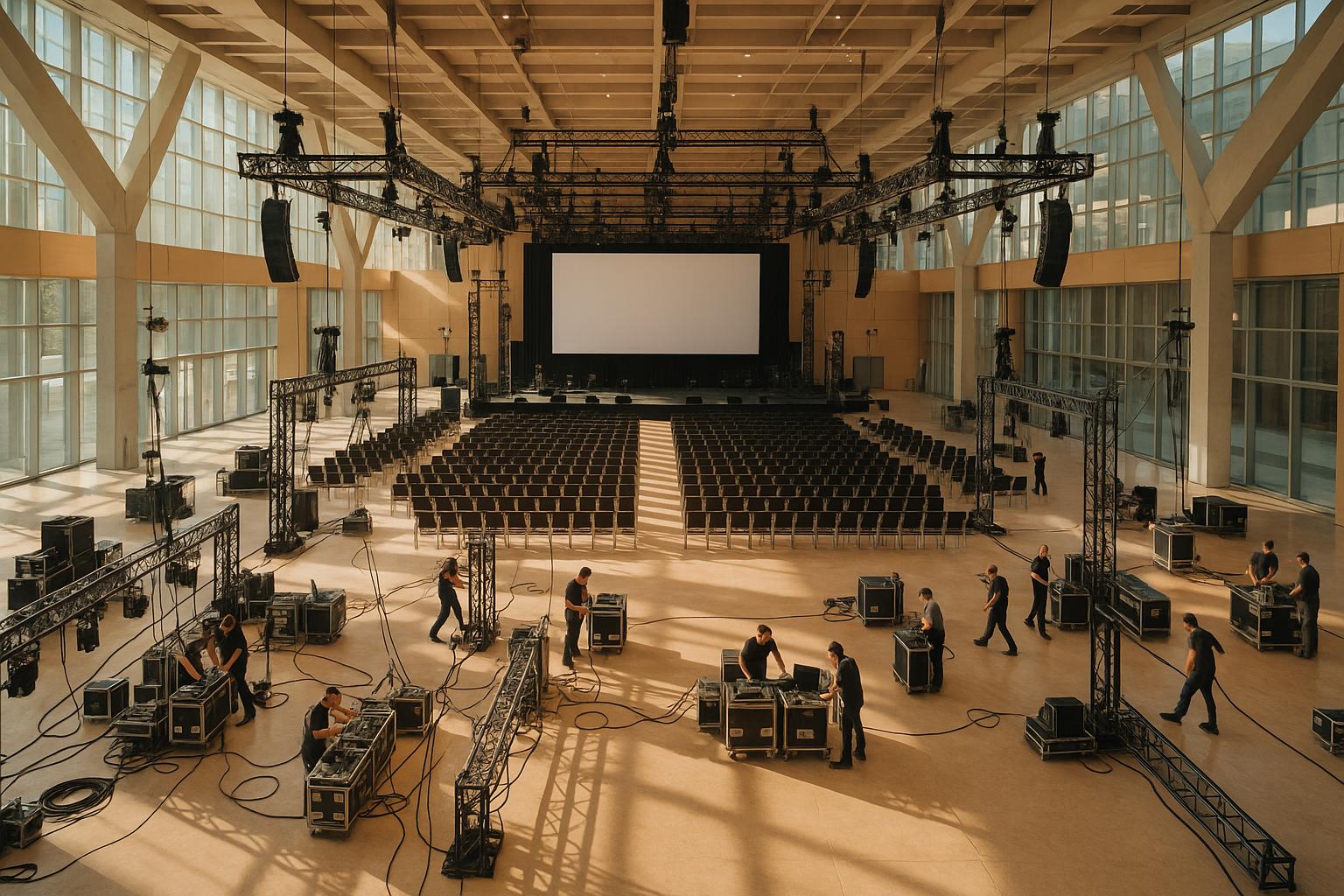Common Mistakes in Corporate AV Production

Chief Executive Officer

Corporate AV production is critical for delivering smooth, professional events. Yet, many organizations face avoidable issues that can derail their efforts. Here’s a quick rundown of the most common mistakes and how to avoid them:
- Poor Planning: Treating AV as an afterthought leads to confusion and missed details. Always define objectives, create run-of-show documents, and outline technical needs early.
- Budget Issues: Underestimating costs or cutting corners on equipment and staffing results in unreliable setups. Allocate funds for quality gear, specialists, and backup systems.
- Technical Errors: Using the wrong equipment, skipping tests, or failing to account for venue-specific factors often causes glitches. Test thoroughly and plan for redundancies.
- Sound Problems: Skipping sound checks or rushing audio setup creates feedback, uneven levels, and dead spots. Conduct full-scale rehearsals and monitor audio during the event.
- Communication Gaps: Vague instructions, last-minute changes, and unclear roles lead to chaos. Use cue sheets, site visits, and real-time communication tools to stay aligned.
- No Post-Event Review: Ignoring feedback means repeating mistakes. Analyze technical performance, audience feedback, and engagement data to improve future events.
The key to success is early preparation, clear communication, and thorough testing. When these elements are prioritized, AV production becomes a seamless part of the event experience.
How to Avoid These Common A/V Rental Mistakes - From an Event Producer
Poor Pre-Event Planning and Preparation
When it comes to corporate AV production, success hinges on more than just technical expertise - it starts with meticulous pre-event planning. Unfortunately, poor planning is a common pitfall that can derail even the most skilled AV teams. Without a solid foundation, technical challenges and coordination issues are almost inevitable.
One of the biggest mistakes organizers make is treating AV as an afterthought. While they may focus heavily on content and logistics, neglecting AV planning early on often leads to unnecessary complications during the event.
Missing Clear Objectives and Run-of-Show Documents
A lack of well-defined objectives can leave AV teams scrambling. Without a clear understanding of the event’s goals, it’s difficult to determine the right equipment, lighting, or audio setup. For instance, the AV requirements for a product launch are vastly different from those for an earnings presentation or a training session. When these goals aren’t outlined, confusion reigns.
Equally critical is the absence of detailed run-of-show documents. These serve as the roadmap for AV execution, specifying technical cues, transitions, and equipment changes. Without them, teams are left guessing, which can lead to last-minute chaos. For example, one team might assume another is handling a key AV component, only to discover the oversight when it’s too late.
Proper planning begins with a thorough technical requirements document. This should cover everything from power and internet needs to room acoustics and equipment specifications. A well-thought-out timeline is also essential, accounting for setup, testing, rehearsals, and breakdowns. Skipping these steps opens the door to technical hiccups and miscommunications, jeopardizing the event’s success.
Budget and Resource Planning Problems
Even the most detailed plans can fall apart without proper budgeting. Insufficient funds often lead to technical compromises that undermine the event’s quality. A common mistake is basing budgets on past events without accounting for new technical demands or rising costs. This approach can leave teams underprepared, especially when equipment costs are underestimated.
For instance, opting for consumer-grade equipment might save money upfront but can result in failures at critical moments when reliability is non-negotiable. Similarly, relying on a single technician to handle multiple tasks increases the likelihood of errors and delays. Professional AV productions typically require a team of specialists, including a technical director, to ensure smooth operations.
Budget cuts made at the last minute can be particularly damaging. Teams may be forced to use cheaper alternatives or eliminate backup systems, which might save money initially but can lead to costly technical failures during the event.
Time is another resource that’s often underestimated. Professional AV setups demand sufficient time for equipment installation, testing, rehearsals, and final adjustments. Skimping on this time can lead to rushed setups and missed details.
Geography also plays a role in budgeting. Events in major cities often come with higher equipment rental fees and labor costs, while remote locations may incur additional transportation expenses for specialized gear. To mitigate these challenges, budget plans should include contingency funds. These reserves allow teams to address unexpected issues, such as equipment failures, without compromising the event’s quality.
Ultimately, poor budgeting and resource planning can have a ripple effect, undermining not just the AV production but the overall professionalism of the event itself.
Technical Problems in AV Setup
Even with careful planning and a solid budget, technical issues in AV setups can throw a wrench in corporate events. These challenges often arise from poor equipment choices, lack of testing, or overlooking venue-specific factors. Recognizing these common problems can save event teams from costly mistakes that might undermine the professionalism of their presentations. Addressing these technical hurdles is key to ensuring everything runs smoothly.
One major source of trouble is rushing the setup or assuming that equipment will work seamlessly in every venue. The reality is that what performs well in one location may fail in another, especially when factors like acoustics and power requirements vary widely.
Wrong Equipment Selection and Setup
Using the wrong equipment for the venue is a frequent misstep. For example, failing to consider the venue's acoustics when selecting speakers or microphones can lead to poor sound quality, making it hard for audiences to follow the presentation. A small boardroom and a large conference hall demand entirely different audio setups, yet teams sometimes adopt a one-size-fits-all approach.
Mistakes in microphone selection can be particularly disruptive. Choosing the wrong microphone often results in feedback, poor sound pickup, or distracting noise from handling. The solution lies in customizing the sound setup to suit the venue. This might mean using specialized speakers, adding dampening panels, or opting for directional microphones to manage challenges like echo and background noise.
Another issue is outdated equipment. Grainy projectors or crackling speakers can ruin the polished image companies aim to present. Modern events often require 4K displays, hybrid-ready streaming setups, and wireless systems to meet today’s standards.
Compatibility problems are another common headache. Insufficient or incorrect audio and visual inputs/outputs can lead to last-minute scrambles for adapters or new equipment. For instance, soundboards need enough audio inputs, including backups, while video systems require compatible inputs and proper switchers for all connected devices.
Cable management is also a frequent source of frustration. Poorly handled cables not only look unprofessional but can also create safety hazards. A better approach involves using wireless solutions when possible, covering cables in public areas, neatly organizing backstage setups, and keeping AV, power, and data lines separate.
Equipment Testing and Backup Systems
Choosing the right equipment is only half the battle - thorough testing and reliable backups are equally important. Skipping these steps often leads to preventable failures. Teams sometimes assume that equipment working in a warehouse will perform the same at the venue, but factors like power fluctuations and connectivity issues can cause unexpected problems.
The biggest oversight is not having backup systems for critical equipment. When primary systems fail during a live event, the absence of backups can bring everything to a halt and harm the event’s reputation.
"The AVIXA Best Practices stress redundancy as a core principle of successful event production rental - especially for large-scale corporate or entertainment events."
Backup planning should cover everything from extra microphones and offline media files to battery backups and redundant power and signal paths. This ensures a seamless switch to backup systems if something goes wrong.
Testing protocols should go beyond individual equipment checks to include system integration. Teams need to verify audio levels, video signal quality, wireless interference, and the functionality of backup systems before the event begins. Investing in quality equipment, support, and backup solutions helps prevent disruptions and keeps the event running smoothly.
Microphone Type Comparison
Selecting the right microphone is critical for achieving clear audio and accommodating presenter needs. The choice affects both sound quality and the speaker’s mobility, making it a key factor in event success.
| Microphone Type | Pros | Cons |
|---|---|---|
| Lavalier mics | Ideal for formal presentations | Can pick up ambient noise |
| Handheld mics | Reliable for Q&As or panels | Awkward for speakers who gesture frequently |
| Headset mics | Great for dynamic speakers who move around | May require practice to use comfortably |
The choice of microphone should depend on the presenter’s style, movement, and the room’s acoustics. Lavalier microphones work well for executives delivering speeches from a podium. Handheld mics are a better fit for panelists or Q&A sessions. For speakers who move around or interact with visual aids, headset microphones are often the best option.
Sound Checks and Audio Management
When it comes to corporate presentations, sound checks are just as crucial as the overall AV setup. Clear, reliable audio is non-negotiable - skipping sound checks can lead to feedback, uneven levels, or outright technical failures that undermine your event's credibility. The contrast between events with well-executed sound checks and those without is stark: one ensures smooth communication, while the other leaves audiences frustrated and organizers scrambling.
Audio issues don’t just disrupt the moment; they send a signal about a company’s attention to detail. If an executive’s message is lost due to a faulty microphone, the repercussions go beyond embarrassment - it can derail key business objectives.
Problems From Skipping or Rushing Sound Checks
Skipping or rushing sound checks invites a host of problems. Feedback loops, uneven audio levels, and malfunctioning microphones are just the start. Overlooking the venue’s acoustics can lead to echoes and muffled sound, while poor microphone choices might result in pops or erratic volume shifts.
Without redundancy or live monitoring, minor issues - like dead batteries or misadjusted gain knobs - can snowball into major disruptions during a presentation. Procrastinating audio planning can also lead to tight budgets, limited equipment availability, and rushed technicians, all of which compromise sound quality. A structured, on-site sound check process is essential to avoid these pitfalls.
How to Conduct Effective Sound Checks
A proper sound check goes beyond basic testing - it’s about simulating real-world conditions. Run a full-scale rehearsal at live volume, complete with presenters using their actual microphones, slides in operation, and, if possible, replicating ambient crowd noise. This allows you to fine-tune gains, EQ settings, and monitor feeds in a realistic environment. Once everything is dialed in, lock the console to prevent last-minute changes.
Test all audio components for proper calibration and levels. Walk the room to identify dead spots or areas with excessive volume.
"The Acoustical Society of America emphasizes that even small changes in room layout can impact sound dynamics. A complete test run ensures your audio/visual equipment rental performs flawlessly in context - not just in theory." - Gear Connection
Start early by factoring audio needs into venue selection. Coordinate details like power drops, rigging points, and load-in schedules. About six to eight weeks before the event, request a detailed gear list and staffing plan from your AV provider. Once contracts are signed, conduct an acoustic walk-through to optimize speaker placement and address any architectural quirks. Consider adding drapes, baffles, or soft surfaces to improve acoustics, and budget for additional fill speakers if necessary.
To prepare for the unexpected, keep spare batteries and backup microphones on hand. Double-check that your mixer board can handle all required audio inputs, including backups, and have an extra mixer ready if needed.
Comparison of Events With and Without Sound Checks
The table below illustrates the clear differences between events that prioritize sound checks and those that don’t:
| Outcome | With Sound Checks | Without Sound Checks |
|---|---|---|
| Audio Clarity | High, with balanced levels and minimal feedback | Garbled sound with screechy feedback and uneven levels |
| Attendee Satisfaction | High, with an engaged audience and seamless experience | Low, marked by distractions and a damaged brand image |
| Technical Issues | Few, resolved before the event | Frequent microphone cut-outs, feedback, and dead spots |
| Professionalism | Reflects thorough preparation and professionalism | Appears amateurish and creates a stressful environment |
Events lacking proper sound checks often suffer from microphone failures, feedback, and dead spots. In contrast, those with thorough preparation deliver consistent audio quality, keeping audiences engaged and ensuring the success of corporate communications. This attention to detail reinforces both technical reliability and the overall event planning process.
sbb-itb-ae35a94
Communication Problems With AV Teams
While having the right equipment and technical setup is critical for corporate AV events, effective communication is what truly determines success. Without it, even the most thoroughly planned events can face setbacks like technical glitches, missed deadlines, or budget overruns. When event planners and AV teams fail to share information clearly, it creates a ripple effect - turning what could have been a polished production into a chaotic experience. In many cases, the difference between a flawless presentation and a technical nightmare comes down to how well everyone involved communicates at every stage of the process.
These communication issues don’t just impact the technical side - they can affect the entire event. If AV technicians aren’t clear on the event’s goals or presenters aren’t briefed on what the equipment can and cannot do, the result is often a fragmented production. This not only disrupts the flow of the event but can also leave a negative impression on attendees, reflecting poorly on the organization as a whole.
AV Team Coordination Challenges
Some of the most common coordination struggles arise from vague instructions and mismatched expectations. For instance, event planners might say, “We need great sound,” but fail to provide details like audience size, room acoustics, or specific presenter needs. Left to interpret these broad directives, AV teams may make assumptions that don’t align with the actual requirements of the event.
Last-minute changes are another frequent issue. Imagine a presenter decides to switch from a podium microphone to a wireless headset just 30 minutes before the event starts. Or the room layout is altered without notifying the AV team. These changes often require quick adjustments, such as swapping equipment, rerouting cables, or recalibrating sound, all of which can eat up valuable time and create unnecessary stress.
Timeline misalignment adds even more complexity. For example, event planners might schedule a 2:00 PM start time and assume AV setup can happen alongside catering prep or attendee registration. However, AV teams typically need uninterrupted access to the space to test equipment at full performance levels - something that’s impossible when other vendors are working in the same area.
Another frequent issue is unclear role definitions. Questions like “Who’s managing the presentation slides?” or “Who’s responsible for handing out microphones?” often go unanswered until a problem arises mid-event. Without clearly assigned responsibilities, important tasks can slip through the cracks.
Budget misunderstandings also create friction. Event planners may approve an equipment list without realizing it requires additional power, labor, or setup time. This can result in AV teams arriving on-site only to discover they can’t deliver the promised services within the budget or given timeframe.
Communication Tools and Methods
To address these challenges, structured communication tools can significantly improve coordination between AV teams and event planners. One essential tool is a detailed cue sheet. This document should outline every technical transition, presenter change, and equipment requirement, down to the exact timing (e.g., “Keynote starts at 9:30 AM EST, wireless mic handoff at 10:15 AM”). Including contingency plans for common issues, like microphone malfunctions or software crashes, can also prevent last-minute chaos.
Pre-event site visits are another critical step. By scheduling a walkthrough at least two weeks before the event, the event planner, lead AV technician, and key presenters can identify potential challenges, such as power outlet locations or room acoustics, and plan accordingly. These visits help eliminate surprises on the event day.
For multi-day events, daily communication schedules can keep everyone aligned. Setting specific check-in times - such as 7:00 AM before setup begins and 30 minutes before each session - provides an opportunity to review updates, confirm presenter needs, and address any concerns before they escalate.
A centralized contact list is invaluable during the event. This list should include primary and backup contacts for each vendor, along with their specific responsibilities. Distributing this information to all team members ensures that issues are directed to the right person without unnecessary delays.
During the event itself, real-time communication tools like two-way radios or messaging apps are essential for quick coordination. Establish clear protocols for handling different types of updates - technical issues go directly to the AV lead, while schedule changes are routed through the event manager. This reduces confusion and ensures that critical information reaches the right people.
Finally, post-event debriefs should take place within 48 hours to capture feedback while it’s still fresh. Use this time to document what went well, identify communication gaps, and create actionable steps for future improvements. These sessions often reveal patterns that can be addressed with better processes, not just better equipment.
The foundation of successful AV coordination is clear and consistent communication. When every team member knows their role, has access to up-to-date information, and understands who to contact for specific issues, the technical side of the event becomes a seamless part of the overall experience - not a source of stress or uncertainty.
Post-Event Review and Improvement
Thorough planning and clear communication might set the stage for a successful event, but the work doesn’t end when the curtains close. A solid post-event review is a critical step that many planners overlook. Skipping this process can lead to missed opportunities to refine future events, save money, and address recurring technical hiccups. The best corporate events don’t just run smoothly - they’re also carefully analyzed afterward to ensure continuous improvement.
By reviewing the event’s outcomes, you can connect your AV choices to its overall success. This involves tracking audience engagement, evaluating technical performance, and assessing whether your AV investments paid off. Regular reviews help minimize technical issues, make better use of budgets, and improve attendee satisfaction.
Ignoring Post-Event Feedback
Neglecting feedback after an event is like leaving a puzzle unfinished. For instance, imagine audio problems during a keynote speech. If you don’t investigate what went wrong - whether it’s microphone placement, speaker alignment, or the room’s acoustics - you risk repeating the same issues next time. Without feedback, you might also waste money on equipment or services that don’t add value. Persistent technical problems can frustrate presenters, shaking their confidence in the AV setup and even discouraging them from participating in future events. Plus, ignoring attendee insights, like complaints about poor sightlines or audio dead zones, can lead to stagnant event quality while audience expectations keep rising.
Using Post-Event Analytics
A meaningful post-event review hinges on gathering and analyzing data that shines a light on AV performance. Metrics like foot traffic and dwell time - how many people visited interactive displays and how long they stayed - offer clear evidence of what worked. Engagement data from tools like audience response systems, event apps, or click-through rates can reveal which AV elements truly connected with attendees. Beyond the numbers, qualitative feedback from post-event surveys, presenter comments, and technical incident reports rounds out the picture. Together, these insights help you evaluate whether your AV investments delivered and guide smarter decisions for the next event.
Conclusion: Preventing Corporate AV Production Problems
Producing a flawless corporate AV event hinges on a combination of careful planning and open communication. The key to a smooth event lies in tackling the basics early and thoroughly.
As we’ve discussed, meticulous planning and thorough testing are your best defenses against AV hiccups. Start with a solid foundation - define clear objectives and document every detail. Even the most skilled AV team can face challenges without these essentials. Regular sound checks are another must, acting as a safeguard against audio glitches that could disrupt your event.
Communication is the glue that binds vision to execution. Experts emphasize the importance of staying in constant contact with your AV team. While they bring the technical know-how, your input about the event’s goals and audience needs ensures they can make informed decisions. This collaborative approach not only minimizes problems during the event but also helps refine processes for future productions.
Don’t overlook the value of post-event analysis. Feedback from presenters, audience engagement data, and a review of technical performance provide invaluable lessons. Addressing and learning from any issues ensures they’re less likely to happen again. By incorporating these insights into future planning, you create a cycle of continuous improvement.
Corporate AV production works best when treated as a partnership. When event planners and AV teams collaborate with clear communication, detailed preparation, and mutual respect, technical issues become rare. Adopt these strategies to set the stage for consistently successful events.
FAQs
How can I plan and budget for corporate AV production to avoid common mistakes?
To plan and budget effectively for corporate AV production, start by defining clear goals for your event. A good rule of thumb is to set aside 15-20% of your total event budget specifically for AV needs. This allocation helps ensure you have the resources to deliver a polished, high-quality production. Work backward from the event date to create a detailed timeline, leaving enough room for sound checks, equipment setup, and any troubleshooting that might arise.
Pay close attention to major cost categories like equipment rental, labor, and venue requirements to avoid surprise expenses. You can reduce costs by exploring options like early booking discounts or bundled service packages. Start your AV planning early in the process and build redundancy into critical systems to lower the chances of technical hiccups during the event. With careful preparation, you can deliver a smooth and professional AV experience that leaves a lasting impression on your audience.
What are the best practices for sound checks and audio management during corporate events?
To deliver top-notch audio at corporate events, start with a thorough sound check well before the event kicks off. Test every piece of equipment - microphones, speakers, and mixers - making adjustments to volume, bass, and treble to fit the venue's acoustics and the audience size. Select microphones tailored to the needs of each speaker or presentation to ensure everyone is heard clearly.
Once the event is underway, keep a close eye (and ear) on the audio. Monitor the sound in real time to maintain clarity and consistency, and be ready to tweak settings on the spot if any issues pop up. Clear communication with your AV team is crucial for quick troubleshooting. With careful preparation and attentive management, you can provide seamless, professional audio that elevates the event for everyone involved.
What’s the best way to ensure smooth communication between event planners and AV teams to avoid technical problems?
To create smooth communication and coordination between event planners and AV teams, it's crucial to bring AV professionals into the loop early in the planning process. Provide them with detailed event schedules, technical requirements, and clear expectations well in advance. Defining roles and responsibilities upfront can also help eliminate misunderstandings.
Plan a comprehensive pre-event briefing to align on objectives, address potential challenges, and ensure everyone is working toward the same goals. Maintain open and consistent communication throughout both the planning and execution phases. This teamwork helps to minimize technical hiccups and keeps everything running smoothly for a successful event.
Related Blog Posts









